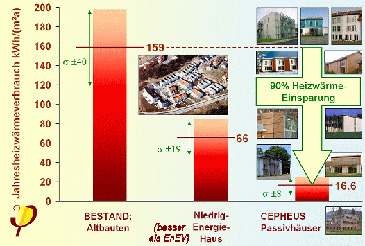
The Passive House (www.passivhauskurs.de) is the world’s leading standard in energy efficient construction: Energy saved on heating is 80% compared to conventional standards of new buildings. The energy requirement for heating is lower than 10 to 20 kWh/(m²a) (depending on climate), adding up to a low cost of 10 to 25 € per month. Therefore high energy prices are no longer a threat to Passive House occupants.
Exceptionally efficient components and a state of the art ventilation system, achieve these huge savings without compromising comfort, but rather increasing it.
The Passive House concept is a comprehensive approach to cost-efficient, high quality, healthy and sustainable construction. The concept is easy to understand:
1. Contemporary construction is quite airtight, therefore the air replacement from infiltration is not sufficient. Ventilating by opening windows is not a convincing strategy either. Getting a sufficient volume of fresh air is not just a question of comfort, but a requirement for healthy living conditions. Therefore mechanical ventilation is the key technology for all new construction as well as refurbishment of existing buildings. Mechanical ventilation will work in all cold and all hot climates since in an airtight house, the heating and cooling energy required will be significantly less.
2. Even though mechanical ventilation systems raise initial investment costs, if designed efficiently they will reduce energy costs significantly, eventually paying off the initial cost. Ventilation units suitable for Passive Houses allow for an economic operation.
3. Now we explain the central “trick” of the Passive House concept: The fresh air needed is entering the room anyhow. If one could use this air to cover the heating load, without increasing the mass flow, without recirculated air, without noise and without drafts – then the ventilation will pay off a second time.
4. This concept of “fresh air heating” is only possible in a building with superior thermal insulation, just like a Passive House. For experts: This is the defining requirement; the maximum heat load should be lower than 10 W/m² , allowing the fresh air to carry the heat load.
Passive Houses require superior design and components with respect to:
* insulation
* design without thermal brigdes
* air tightness
* ventilation with heat recovery
* und
* innovative heating technology
To realise an optimal interaction of all components, an energy balance of the building has to be worked out. And step by step any new design may be improved to meat Passive House standards.
Thousands of Passive House dwellings are already occupied. Examples will be shown in workshops at the Passive House Conference:
* Design, redesign, create scopes of opportunity: architecture and the Passive House
* Passive commercial buildings
A tour of built examples will take place place on April 13th, 2008.
Podcast on Passive Houses: The Passive House.
Additional information about the Passive House concept.
